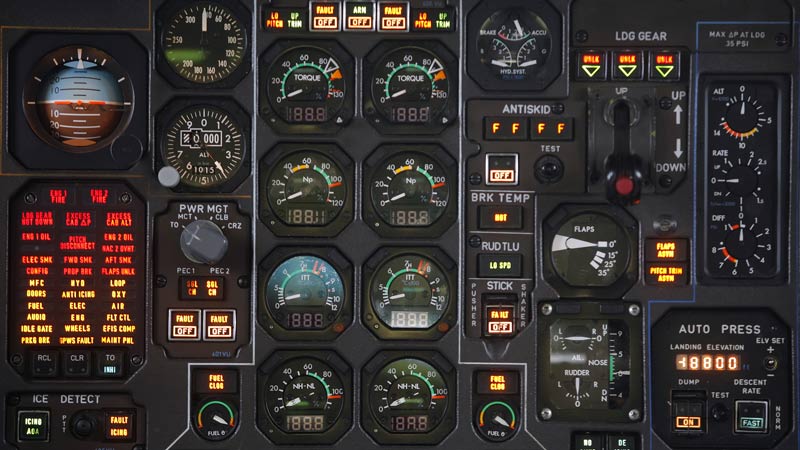
On February 19th, 1985, China Airlines Flight 006 was slightly north of San Francisco, cruising at 41,000 feet. It was 10 hours into its daily flight from Taipei to Los Angeles. So far, it had been a normal flight. The highly experienced crew had no reason to expect the remaining flight time would any different.
Suddenly, one of the engines burned out and failed. This isn’t all that dangerous or unusual—loss of a single engine on a 747 would usually result in a precautionary diversion if the destination airport was a great distance away. The aircraft can fly reasonably well on three engines, certainly well enough for this not to be a huge emergency.
The 747 flight manual states that the pilot should descend to 30,000 feet and try to restart the engine. However, the pilot attempted an immediate restart. It failed. The puzzled crew focused their attention on further efforts to restart the engine.
Because of this focus, the crew didn’t realize that the plane had started to bank to the right due to the loss of thrust from the failed engine. Because of how the autopilot is set up during prolonged flight, it was unable to correct this bank. So the plane continued to turn until it reached an angle more than four times the bank found in standard flight. At this point, the plane began to pitch forward, and entered a dive. An alarm alerted the pilot to this dive.
The pilot disconnected the autopilot and took manual control. He noticed that the plane was losing airspeed. So he pushed the nose down further in an attempt to increase the speed. As the plane was now in heavy clouds, the aircrew had no visual stimuli. Instead, they had to focus on their instruments, which were telling them that they were in a severe dive. However, because the angle of the dive was so great, the flight crew thought the instruments were faulty and disregarded them.
At this point, the plane was pointing straight down. It wasn’t until it broke through the cloud cover at 11,000 feet did the crew realize what was actually going on. The pilot and co-pilot pulled back on their sticks as hard as they could in an effort to regain control, which they managed at just over 9,000 feet.
They had dropped over 30,000 feet in less than two minutes, which I imagine was an incredibly uncomfortable experience for the passengers. The plane had undergone forces it was not designed to handle and suffered severe damage to the horizontal stabilizers. Fortunately, the pilot diverted to San Francisco and made a successful landing. Everyone survived—but only just.
So why am I telling you this story, interesting as it all is? It is a great example of how people make poor decisions under pressure. In the case of Flight 006, the aircrew were so preoccupied with the faulty engine that they lost focus on the correct process and made poor decisions, almost turning a reasonably benign situation to a deadly one.
As a former athlete, I am well-acquainted with—and interested in—pressure. Why do some athletes compete really well in major championships? Conversely, I am sure we can all think of someone who always promised so much, but could never deliver the goods on the main stage. Asafa Powell springs to mind. I have myself been the victim of making poor decisions under pressure. I took off too early in my leg of the 4×100 relay at the 2008 Olympics. I also grossly underperformed in the 2008 British National Indoor Championships. Pressure affects us all in different ways, and the key for athletes is to learn how to harness pressure and use it to improve their performance.
What is pressure? In sports, it is a psychological stressor that refers to feelings an individual has about an upcoming competition. It can be intrinsic/internal, created by the athlete with thoughts such as “I must run well,” or “This is a big race I have to win.” It can also be affected by external/extrinsic factors, such as a big buildup in the media, or a coach placing added importance on a race.
All athletes have to deal with pressure. Here are some simple techniques which can be used both to control pressure and to improve performance in high-pressure situations.

Reframe Pressure
Is pressure good or bad? Your answer determines how likely you are to be affected by high-pressure situations.
If you perceive pressure as negative, you will associate it with negative thought processes such as self-doubt. You are also likely to attempt to consciously increase your effort in an attempt to improve performance. Sprinting is a subconscious skill. Once it becomes conscious the whole action becomes slower and more deliberate. Slow sprinting does not lead to success in races!
However, if you perceive pressure as positive, feeling its signs could improve your performance. Recognizing that nerves and pressure can facilitate good performance is an important step in reframing your approach to them. Nerves and pressure are “facilitative”: they put into action a set of processes that can make you run quicker or perform better, such as the release of adrenaline which increases heart rate and breathing rate.
The key, then, is to reframe pressure to make it seem positive. Start to realize that nervous feelings are facilitative, and therefore associated with an improvement in performance. Have an internal dialogue with yourself, using key phrases to reinforce the positive aspects of pressure. You might say something like “I’m nervous, and I always run well when I’m nervous.” Connecting a physical symptom (nerves) and a positive outcome (running well when nervous) gives a positive attitude—and therefore an increased likelihood of improved performance.

Reduce External Sources of Pressure
Pressure can be both internal and external. External pressure comes from sources such as friends, family, coaches, and the media. To an extent, this type of pressure is out of your control. But there are ways of managing it.
Conversations with friends and family to make them aware that they are potential sources of pressure can be useful. Parents in particular want to look after you, and this can be overbearing. If your parents view a race as important, they’re likely to pass this feeling on to you. Fortunately, my parents were incredibly level-headed and I don’t recall ever feeling pressure from them. My father gave me his “dad talk” well in advance of big races. He said it didn’t really matter how well (or poorly) I ran, which was useful in approaching them. A great book for parents of promising athletes is The Sports Motivation Masterplan by Lee Ness. It contains a chapter on how parents can best support their children.
A coach can also increase the pressure on the athlete, often unknowingly. Nervous, panicky coaches are likely to pass along their unease. I’ve seen coaches—sometimes my own—get nervous and twitchy in the run-up to big races. That’s not helpful.
If you’re a coach, be aware that your athletes are looking for you to be a calming influence, able to make rational decisions. This may not be easy for you, so don’t be afraid to seek help from sports psychologists or other experienced coaches. You could also ask your athletes for their feedback!
Finally, the athlete must manage media-generated pressure. Remember that talking yourself up to reporters close to a big race might increase the pressure you feel. If so, try to temper expectations without coming across as low in confidence. Or you can simply ignore the media in the run-up to an event. It won’t matter what is written about you because you won’t be reading it!
It is also important to consider the impact of social media. If you’re constantly posting ahead of a big race, you may be subtly increasing the pressure on yourself to perform. I’ve noticed that the best athletes generally post very little about big races or how training is going. Instead, it seems to be the athletes the level below who make these postings. I often allow myself a wry smile when they post after an event in which they underperformed, blaming some extraneous variable. Could their underperformance be due to the high pressure from constant social media updates?

Reduce Internal Sources of Pressure
As athletes, quite often the largest source of pre-race pressure comes from ourselves. We are desperate to perform well, and some competitions don’t come around too often (like the Olympic Games). Depending on our mental skills, genetic makeup, and experience, how we respond to this increased pressure will be different. Some athletes need a bit more pressure (me); some desire less (Asafa Powell). Managing this internal pressure load can improve performance.
Part of this management comes by pressure reframing, which I discussed above. It also comes from experience. Athletes become accustomed to the physiological symptoms of pressure and learn that they can perform well in its presence. This experience of pressure is a good reason why developing athletes should be exposed to competition at the right level—tough enough to feel nerves and pressure, but not too hard to de-motivate them if they are badly defeated.

Recognize the Symptoms of Being Under Pressure
Pressure is a continuum, from none to immense. As you slide along this scale toward higher pressure, certain mental and physiological things start to happen: heart rate and breathing rate increase, and you might feel butterflies in your stomach. Recognizing these symptoms is important, as it allows you to better control them. If you are unable to monitor or recognize these symptoms, then you will go further along the continuum and increase the likelihood of underperformance.
How can we recognize these symptoms? The first way is through experience—exposure to high-pressure situations in a controlled manner allows athletes to a) experience these symptoms, then b) understand what brings them on.
The next step is to implement some sort of body scan. This doesn’t have to be anything spectacular; simply become aware of what is going on internally. It can be as simple as thinking “OK, I can feel my heart rate going up, and I have butterflies in my stomach. I know I am feeling a bit more pressure here.”
Third, this awareness leads to the necessary steps to manage the situation. If athletes are not yet in their zone of optimal functioning they can let the symptoms continue along the scale. If they are close to this zone they can maintain themselves at this level. If they recognize that they have exceeded their optimal zone, they can use breathing management or stress reduction techniques to bring them back down.

Use Pressure in Training
“The way the sapling is shaped determines how the tree grows.”
This quote from James Kerr’s book Legacy illustrates how the environment determines outcome. Through training, coaches must manipulate their athletes’ environment to provide a better outcome. All too often, coaches focus on physiological adaptation at the expense of mental-based adaptations.
While physical adaptation is important, the most physically prepared athlete does not always win the race. Training has to address the issue of performing/racing, which generally happens alongside 7 other people. An individual technical run, or a run against members of a training group (which usually has a well-established hierarchy) does not adequately prepare an athlete for the pressure of competition against athletes of similar ability.
The 4x100m relay, and especially Great Britain’s squad, demonstrates this concept in action. Since 2000, Great Britain has won medals in 5 out of 10 of the major global championships. They were disqualified, did not finish, or had a catastrophic changeover (or all three!) in the 5 others. So if Great Britain successfully gets the baton round, they win a medal. The main flaw has been an athlete leaving early. Is the solution more technical training, or a change in training approach, to better prepare the athletes?
I believe that additional technical training is counter-productive. Instead, the athletes need to be exposed to more pressure during training, to better prepare them for the pressures of competition. This allows them to make their mistakes under pressure in training (e.g. leaving early), and rectify these mistakes BEFORE the competition occurs.
Pressure must be implemented at the right point in time. Think of a particular skill as a ladder. You first learn how to do the skill correctly, with no pressure. As you move up each rung, you add intensity, then volume, and finally pressure. Applying pressure to an unlearned skill is dangerous. Athletes who do not have unconscious competence will revert to type—that is, poor skill execution.
In the case of a relay, athletes would begin by practicing changeovers one by one. They would practice the skill of the takeoff, and completing the baton exchange. Then they would do these maneuvers more quickly, thereby increasing the intensity of the skill. Then pressure would be added with other pairs training together to mimic competition. Athletes are not allowed to leave early, and get feedback after each trial on how well they executed the skill. Exposure to increasing intensities of pressure allows them to experience the pressures of competition and learn how to deal with them.

Have a Checklist
In pressure situations, athletes need to do what they have practiced. Yet, time and again we see athletes (and coaches!) panic and try something different in the heat of competition. To eliminate this situation, it is useful to have a process that the athlete has had success with. This can take the form of a checklist, systematically checking off things once completed.

Though I haven’t competed in athletics at a high level for almost four years, I still remember my checklist. It started the night before the race, with certain processes aimed at mobilizing key areas, as well as relaxing. On race day, I knew what to eat, and when. I knew my caffeine strategy. I knew my warmup times. I even had a Plan B in place for unexpected situations. I used more or less the same checklist for ten years of competing, so it actually took very little mental effort to go through the process. As a result, it reduced the strain on my mental capacity—especially under pressure— and thereby reduced the chance of making poor decisions.
Conclusion
As I remarked at the start of this article, some athletes rise to pressure, while others falter. This pressure gets more intense as the competition becomes more important. Learning how to deal and respond to pressure is crucial to optimal performance. Hopefully this article has provided some guidance on achieving that goal.
Please share this article so others may benefit.
[mashshare]


I play golf for the 5th year and I’m starting to perform badly under pressure. In last years pressure did good to me, now it’s the opposite. In this sport, one does this to himself, it’s usually not done by opponents because normally in a tournament groups are mixed and you don’t know others results. The article makes sense and I will try to apply it. It’s not that I don’t know about sports stress, I play recreational tennis for 30 years.
I’m also a golfer. I belong to an association that plays 45 events a year. We’re set up just like the PGA tour. 4 majors, playoffs, etc. We recently had our first major. I practiced 3x the prior week and played a short course on the Saturday prior to the Sunday event. The day of the event I swear if I felt anymore pressure, I would’ve left the course a foot shorter. I performed poorly, especially the first few holes. I’m struggling with how to “play” at these events instead of feeling like if I don’t perform, someone’s going to take my car away… The funny part is there’s money involved but it’s nothing in the big picture. Way too much thinking go on while I’m trying to “play”. Need to figure out a way around this. I’ll also try to apply the concepts in the article.
I appreciate your tip to try to recognize the signs of being under pressure through experience. My son and daughter both love to play sports, but we just moved and they need to get their physicals done. I’ll remember to talk to my kids about pressure after we find a place to get physicals done.
Stress in sport always occurs especially if there is competition. It is well developed to deal with him on the example of table tennis (unfortunately necessary translation) https://infomiasto.eu/stres-w-tenisie-stolowym-jak-go-pokonac/ it is about dealing with it during confusion comments.